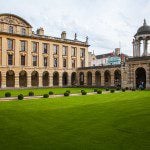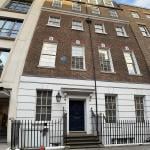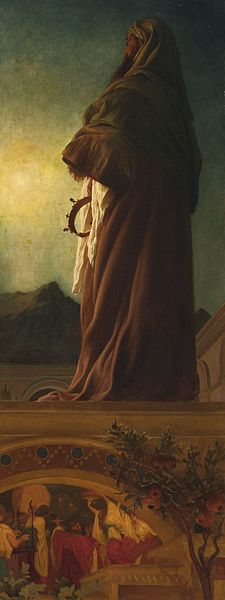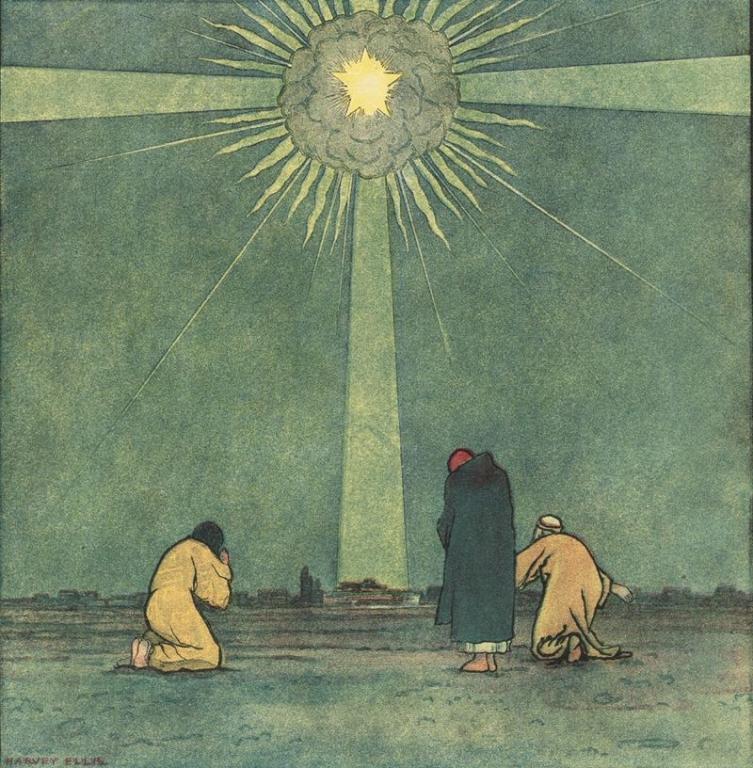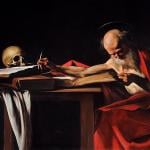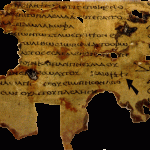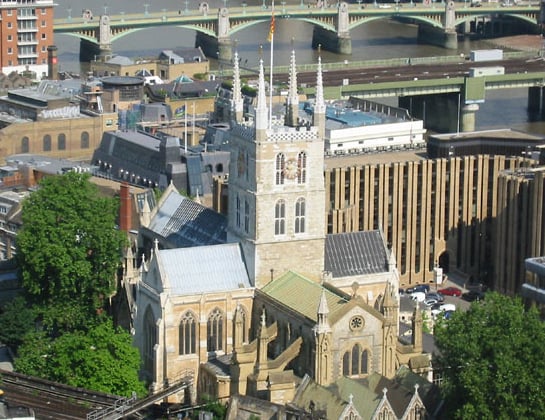
In the morning, we did a walking tour in the borough of Southwark, which lies at the south end of London Bridge. It’s where Shakespeare’s famous Globe Theatre stood in Southwark.
But our focus was on the dark underside of the Victorian city, in which conditions for the poor were truly miserable. We had a local guide named Sue, because Peter Fagg was unable to be with us today. I wish that he had been, because, if I’m not mistaken, Brigham Young and Heber C. Kimball had their lodgings in Southwark (not far from the Cathedral) during their time in London. (I think that the building still stands.)
In 1824, when Charles Dickens was twelve, his father spent three months in the Marshalsea Prison in Southwark for indebtedness. This seems to have had a profound effect on the young Charles, and the financial precariousness that he experienced before, during, and after that imprisonment almost certainly contributed to the themes of his writing. The small alley that runs by the site of the Marshalsea, which is now a nice park, is named after Little Dorrit.
In the afternoon, a few of our number went shopping (e.g., to Harrods, in Knightsbridge), but most came with me for a tour of a small portion of the British Museum. (It has approximately 70,000 artifacts on display, out of a total collection of sixteen million, so we missed a few of them.) We entered from Montague Street, gathering first at the lava statue of Hoa Hakananai’a, a moai from Rapa Nui, or Easter Island, before proceeding further into the Museum. We started off in Room 1, a very good place to start. Its theme is “Enlightenment,” and it’s essentially the former library of George III. I directed them to a replica of the Rosetta Stone and to a brick that’s inscribed with the name of Nebuchadnezzar. Then we passed across the Great Court, where I offered a few brief remarks about the famous Reading Room and the famous people who used it (for good or for ill). Thereafter, we visited the Assyrian rooms (looking at reliefs of lion-hunting scenes and the siege of Lachish, several giant winged gate-guardians, what I suspect was the prototype of “Tash” in the Chronicles of Narnia, and so forth), the “Elgin Marbles” from the Parthenon, the real Rosetta Stone, a giant portrait bust of Ramses II, the black obelisk of Shalmaneser III, the Taylor Prism, a couple of clay cuneiform tablets containing the Babylonian flood story, the Cyrus Cylinder, and so on and so forth. I then dismissed everybody to roam on their own, but a number of us ended up in the large room dedicated to the Sutton Hoo ship burial and the treasure horde that was found with it.
Our group was on its own for dinner tonight. My wife and I returned this evening for the second time in a row (though tonight with a friend from the tour group) to the Baba Ghanouj, a Lebanese restaurant and grill that is directly across the street from our hotel here in South Kensington.
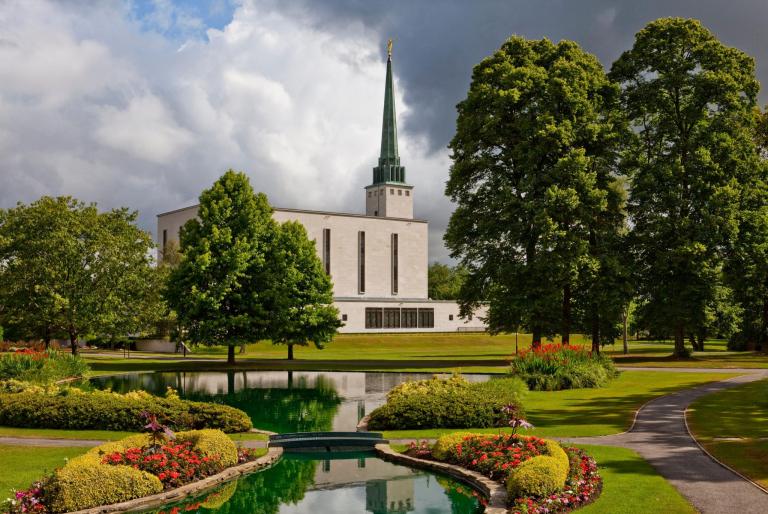
Meanwhile, the Interpreter Foundation continues its long, slow fade — thus fulfilling the eager prophecies of its early and immediate detractors — with these four articles, published earlier today:
“Anachronisms: Accidental Evidence in Book of Mormon Criticisms,” Chapter 4, “Ancient Culture,” written by Matthew Roper
[Editor’s Note: We are pleased to present chapter 4 from a book entitled Anachronisms: Accidental Evidence in Book of Mormon Criticisms. It is presented in serialized form in this volume of Interpreter: A Journal of Latter-day Saint Faith and Scholarship.]
“Interpreting Interpreter: (Non-)Anachronisms – Culture,” written by Kyler Rasmussen
This post is a summary of the article “Anachronisms: Accidental Evidence in Book of Mormon Criticisms — Chapter 4: Ancient Culture” by Matthew Roper in Volume 65 of Interpreter: A Journal of Latter-day Saint Faith and Scholarship. All of the Interpreting Interpreter articles may be seen at https://interpreterfoundation.org/category/summaries/. An introduction to the Interpreting Interpreterseries is available at https://interpreterfoundation.org/interpreting-interpreter-on-abstracting-thought/.
A video introduction to this Interpreter article is now available on all of our social media channels, including on YouTube at https://youtube.com/shorts/2jQ91Ul1QXw.
The Takeaway: Roper continues his examination of claimed Book of Mormon anachronisms, looking at 53 different items related to the book’s representation of ancient culture. He concludes that 87% of these supposed anachronisms have received subsequent confirmation in the archaeological record, with 5 elements that are yet to trend toward confirmation (heliocentric astronomy, identified Book of Mormon cities, synagogues in the New World, pre-Columbian Christians, and Wheat).
“Latter-day Saint Theology and the Problem of Evil,” written by and
Abstract: The classical formulation of God as the sole, self-existent Being and ground of all that exists poses a philosophical problem. If God is omniscient and omnipotent, why does evil exist? Why does he not save humankind from moral and natural evil? If we embrace the full set of classical assumptions of creedal Christianity, these questions have no satisfactory answer and God cannot be absolved of responsibility for evil. This paper reviews and rejects several classical and modern philosophical formulations that try to solve the problem of evil. It then argues that the problem of evil dissolves if we accept Restoration theology in its most compelling form. Pluralism replaces monism, law is largely natural rather than legislated, and the necessity of atonement is located in humanity rather than in God, though God graciously provides the Atonement of Jesus Christ, which makes human exaltation possible.
“Interpreting Interpreter: The Problem of Evil,” written by Kyler Rasmussen
This post is a summary of the article “Latter-day Saint Theology and the Problem of Evil” by Val Larsen and Newell D. Wright in Volume 64 of Interpreter: A Journal of Latter-day Saint Faith and Scholarship. All of the Interpreting Interpreter articles may be seen at https://interpreterfoundation.org/category/summaries/. An introduction to the Interpreting Interpreterseries is available at https://interpreterfoundation.org/interpreting-interpreter-on-abstracting-thought/.
A video introduction to this Interpreter article is now available on all of our social media channels, including on YouTube at https://youtube.com/shorts/_kYAmnv4JX0.
The Takeaway: Larsen and Wright provide an overview of the Problem of Evil, reviewing ways that creedal Christianity attempts to resolve the problem, concluding that LDS theology provides the only comprehensive solution that preserves the morality of God.
Moreover — and I hope to have at least a little bit more to share on this soon — it seems that the 2024 Interpreter Foundation dramatic production Six Days in August recently won a silver “Telly” award in both the Historical film category and the Narrative film category.
Posted from London, England


